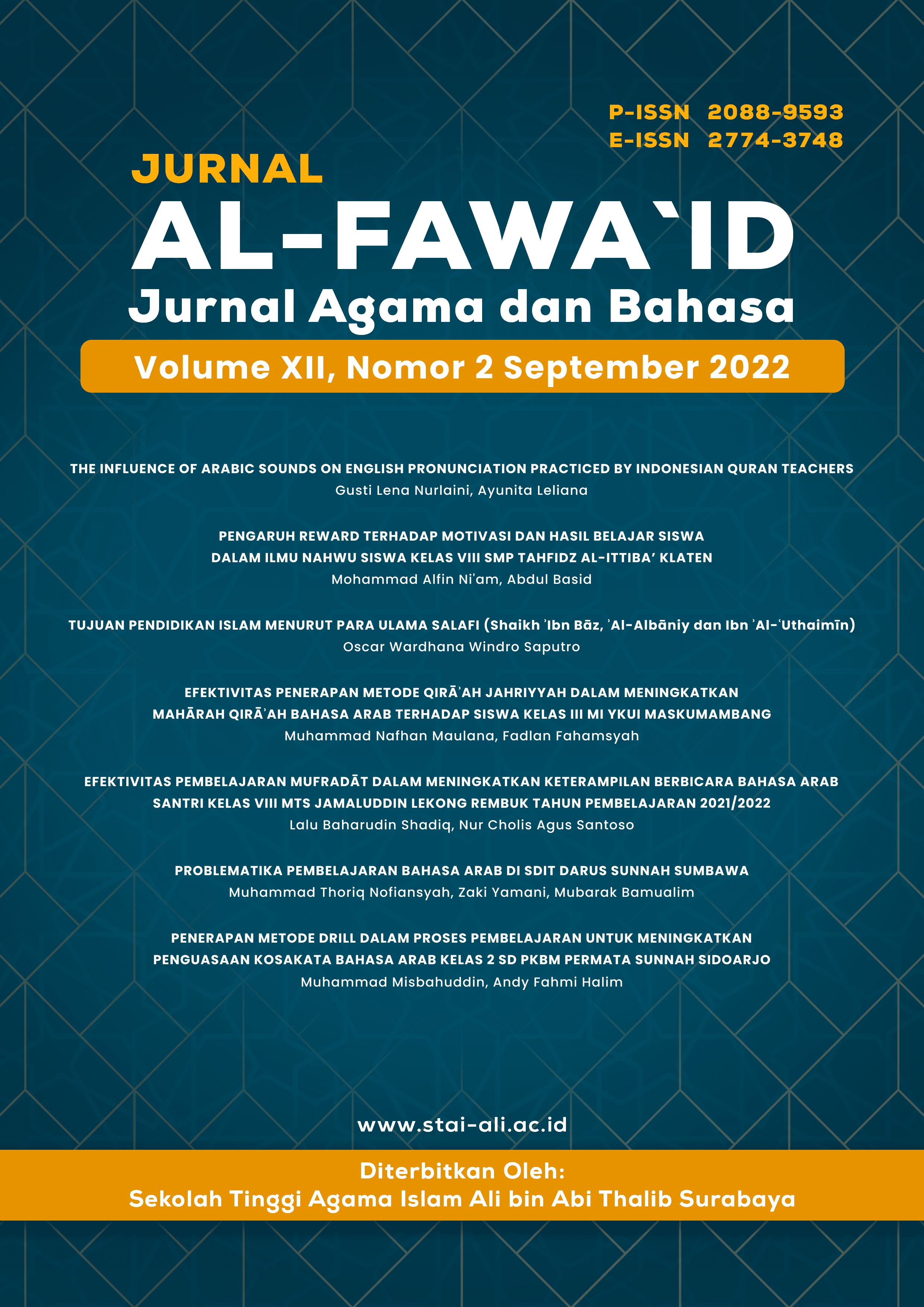THE INFLUENCE OF ARABIC SOUNDS ON ENGLISH PRONUNCIATION PRACTICED BY INDONESIAN QURAN TEACHERS
Authors
Gusti Lena Nurlaini
Ayunita Leliana
Three English fricatives [θ], [ð], and [ʃ] have been confusing many Indonesian people when they pronounce English words. Even though these three sounds are not present in Indonesian, they are found in Arabic. The goal of the research is to reveal if Indonesian Muslims, who are qualified Quran teachers, are able to pronounce English words correctly. The subjects of the research are passive English speakers but still get enough English exposure at college. In order to explore the language phenomenon, qualitative method is applied in this research. Qualitative method is used to describe and clarify experiences in people’s lives. From 60 data involving two subjects, the research showed that the two subjects succeeded in pronouncing 53 English words in total accurately. This phenomenon occurs due to a positive language transfer because Arabic can facilitate them to pronounce some English sounds.
Alshalaan, Khawater. “A Comparison between English and Arabic Sound Systems Regarding Places of Articulation.” Open Access Library Journal 07, no. e5679 (2020).
Alwi, Hasan, Soenjono Dardjowidjojo, Hans Lapoliwa, and Anton M. Moeliono. Tata Bahasa Baku Bahasa Indonesia. Jakarta: Departemen Pendidikan dan Kebudayaan Republik Indoensia, 1998.
Ambalegin, and Fasaaro Hulu. “Efl Learners’ Phonological Interference of English Articulation.” Jurnal Basis 6, no. 2 (2019).
Cresswell, John. W. Research Design: Qualitative, Quantitative, and Mixed Methods Approaches. Third Edit. Los Angeles: Sage, 2009.
Gusdian, Rosalin Ismayoeng, and Riski Lestiono. “The Use of Arabic Consonant Sounds To Arrive At English Pronunciation: A Case Study on Indonesian EFL Students in Tertiary Level.” Erudio Journal of Educational Innovation 5, no. 2 (2018).
Irlina, Andi. “Teaching the Holy Quran to Young Learners (7-12 Years Old)” 9, no. 1 (2019).
Jarvis, Scott, and Aneta Pavlenko. Cross-Linguistic Influence in Language and Cognition. New York: Routledge, 2008.
Komariah, Anis. “Problems in Pronouncing The English Sounds Faced by the Students of SMPN 2 Halong, Banjar.” Journal of English Language and Pedagogy 1, no. 2 (2018).
Lestiono, Riski, and Rosalin Ismayoeng Gusdian. “Arriving at English Pronunciation by Means of Arabic Consonant Sounds: A Case Study on EFL Students in Indonesian Context.” 7th International Conference on Literature, Humanities, Social Sciences and Education (2017).
McMahon, April. An Introduction to English Phonology. Edinburgh: Edinburgh University Press, 2002.
Miles, Matthew, B., A. Michael Huberman, and Johnny Saldana. Qualitative Data Analysis. California: SAGE Publications, 1994.
Odlin, Terence. Language Transfer: Cross-Linguistic Influence in Language Learning. Cambridge University Press, 1989.
Polkinghorne, Donald E. “Language and Meaning: Data Collection in Qualitative Research.” Journal of Counselling Psychology 52, no. 2 (2005).
Setyadi, Ary. “Fonem Deret Konsonan Dalam Bahasa Indonesia.” Nusa 14, no. 1 (2019)
Watson, Janet C. E. The Phonology and Morphology of Arabic. Bogoslovska Smotra. New York: Oxford University Press, 2002.
Yahya, Amalia, and Muliasri Arifin. “The Influence of Arabic Sound toward English Pronunciation at English Department Students of IAIN Palopo.” Journal of English Language Teaching & Learning Linguistics and Literature (2015).
Article Sidebar
Copyright (c) 2022 Gusti Lena Nurlaini, Ayunita Leliana

This work is licensed under a Creative Commons Attribution 4.0 International License.

